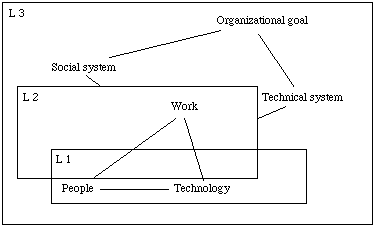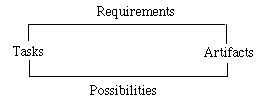3. Components of HCI
This chapter deals with the disciplines involved in HCI and the general
design process in HCI
Disciplines involved in HCI
-
Computer Science (User interface Management Systems - Techniques)
-
Cognitive psychology (Perception, attention, memory, learning, thinking)
-
Social and organizational psychology (attitude, behaviour, group work)
-
Ergonomics and human factors (safety, performance, adaptation)
-
Linguistics (terminology, multilingual systems)
-
Artificial intelligence (automated behaviour)
-
Philosophy (knowledge)
-
Sociology (group behaviour)
-
Anthropology (ethnomethodology)
-
Engineering (tools, techniques, equipment)
-
Design (graphic design, layout, colours)
The basic questions in designing HCI are
-
How users as individuals can use the systems designed for their use
-
How this affects the work situations - jobs
-
How organizational systems and the technology in an organization changes
These interactions are visualized in the next figure (Preece fig 2.4, adapted
from Eason, 1991)

Artefact - Task Cycle
Development of new technoloqies and systems can be seen as a circle of
artefacts and tasks: Artefacts are used in tasks, artefacts make some thing
possible, on the other hand tasks need some tools - artefacts and development
of tasks makes it necessary and possible to develope new artefacts. We
speak of the TECHNOLOGY or the NEEDS of people and organizations as the
driving force of the circle
This can be visualized in the task - artefact cycle (Carrol)

Technology push is also one aspect of the same situation. What
can be done, must be done and sold the the customers. In some ways one
can say that any technological environment is built this way. Consumer
products are typically designed this way (digital broadcasting, tv, GSM)
because the products are not made for any particular customer. The customers
have no way of saying what sort of technology they need.
The companys business systems are more likely to be designed for customers
need and requirements. For example a billing system for a company is tailored
for that particular company and the company can agree on specific features
for the product.
mj@uwasa.fi 13.3.2002

